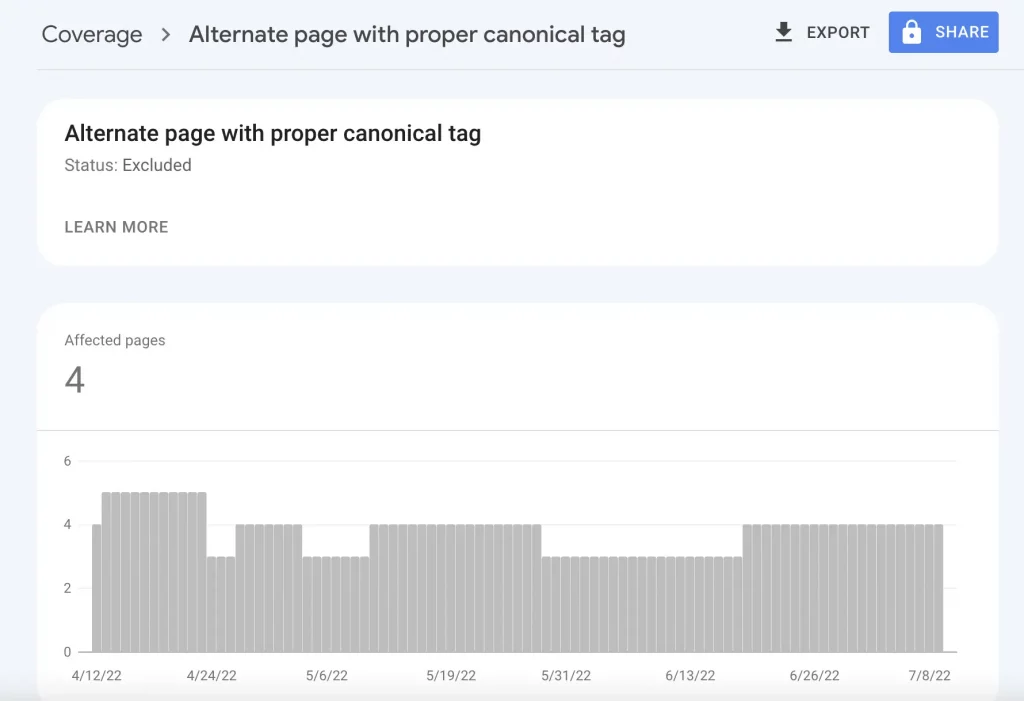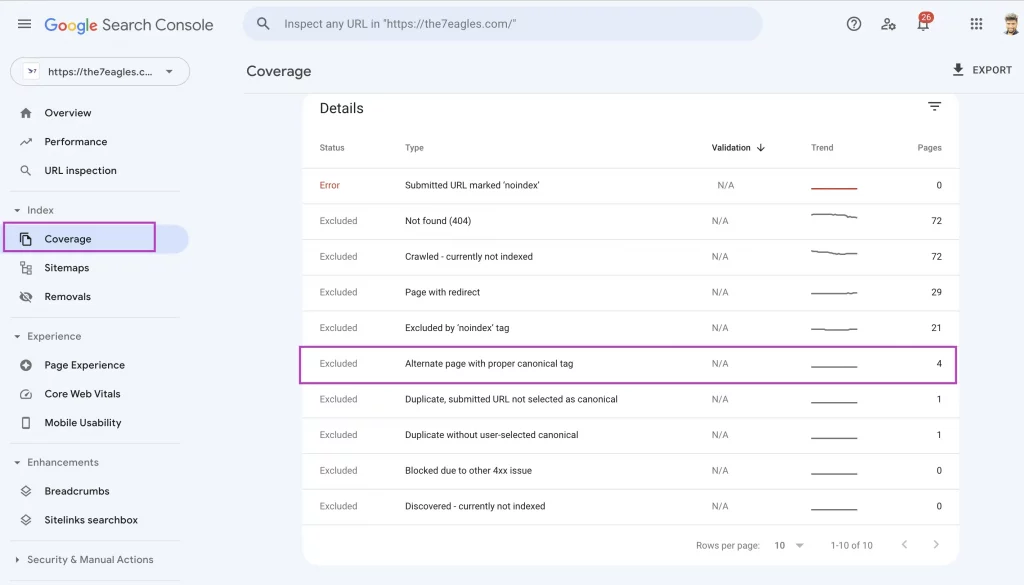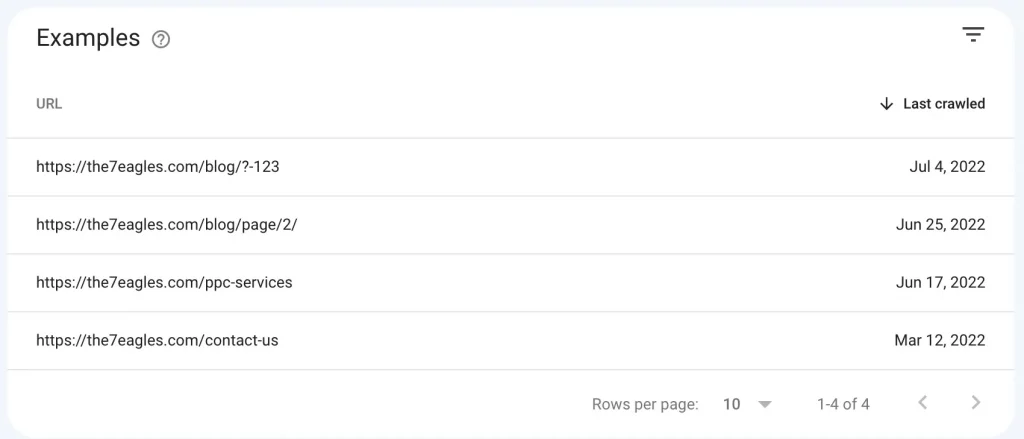Alternate Page With Proper Canonical Tag
There are multiple reasons your web pages are not indexed, and we call
them Google Index Coverage issues. Alternate page with proper canonical
tag is one of the coverage issues.
This type of issue is commonly intimated in Excluded under Coverage
section of the Google search console.
If you see such an issue in the Google search console, then it’s time
to take immediate action, as it could cause problems indexing the targeted
web page and wastage of crawl budget.
In this article, we detail how alternate page with proper canonical tag
appears as excluded and how to fix them.
What is Alternate Page With Proper Canonical Tag?

The are multiple reasons why your web pages are not indexed, and
we call them Google Index Coverage issues. An alternate page
with proper canonical tag is one of the coverage issues
(Page indexing issues).
This type of issues are commonly intimated in Excluded under
Coverage section of Google search console.
If you see such an issue in Google search console, then it’s time
to take immediate action, as it could cause problem in indexing
the targeted web page, and wastage of crawl budget.
In this article, we detail down how alternate page with proper
canonical tag appears as excluded, and the ways to fix them.
What is Canonical Tag?
The HTML tag of Canonical Tag appears as follows,
<link rel="canonical" href="https://the7eagles.com/alternate-page-with-proper-canonical-tag/" />
This tag is useful as the content of particular web pages is
accessible by multiple URLs
Example,
the7eagles.com/blog/
the7eagles.com/blog/page1
the7eagles.com/blog/page2
the7eagles.com/blog/page3
These web pages have similar content, the same title tag,
and meta description. Still, the paginated URL resembles a copy.
So, it would help if you tagged the original URL as canonical for
all the pages. This allows the Google search engine to understand
the original version to index and exclude all other URLs from
crawling and indexing. This saves the crawl budget.
The reasons are listed as follows.
This is one of the reasons why any of your web pages might be
featured on an Alternate page with a proper canonical tag.
Example,
General Version: the7eagles.com/seo-services/
AMP version: the7eagles,com/seo-services/amp/
In this case, these are two URL but holds the same content. So,
Google considers either of the pages as canonical, and index them.
The other would be excluded
from indexing.
Your role here is to check, whether the potential URL is indexed
or excluded.
Protocol like www/non-www http/https:https://example.com/
http://www.example.com/
http://example.com/
Protocols can create multiple URLs with the same content,
and only one gets indexed, and others are excluded.Generally,
an E-commerce website or Blog website uses a search option
to find any product or topic.
Dynamic URLs in Case of Search Parameters:
It often appears as below,
https://example.com/dresses/cocktail https://example.com/dresses/cocktail?gclid=ABCD
https://example.com/dresses/cocktail?gclid=ABCD&color=red
From the above case, the master or canonical URL will be indexed,
and others will be excluded.
Pagination:
Pagination is another case, that can be excluded under alternate
page with proper canonical tag.
This usually occurs when Google bots crawl multiple pages of blogs,
author pages, and many more.
The examples are similar to below
https://example.com/author/page-1 https://example.com/author/page-2
https://example.com/author/page-3
From the above case, the master or canonical URL will be indexed,
and others will be excluded.
How to fix Alternate Page with Proper Canonical Tag Issue?


This is how you need to check the URLs that are affected by the
coverage issues – Alternate page with proper canonical tag.
Here are a few ways to fix this issue by following the steps.
Use a rel="canonical" Link Tag:
- use Canonical link <link rel=”canonical” href =”https://example.com” />
- in the HTML header of the master page.
- Also, insert the duplicate page with the canonical URL of the original
- page.
- If your canonical page has a mobile version URL, add rel=”alternate”
- linking to the page.
<link rel="alternate" media="only screen and (max-width: 640px)" href="http://m.example.com/" />
- Add hreflang or redirects (301 & 302) to the appropriate page,
- if needed.
Use a Sitemap:
Create a sitemap for your website and submit only the canonical URLs.
In a sitemap, all pages are suggested as canonicals; Google will
determine whether duplicates exist based on content similarity.
Sitemaps are useful for telling Google which pages you consider most
important on your site, but Google does not guarantee that we will
count them as canonical.
Strictly sitemaps should not include non-canonical pages.
Use 301 redirects to the Old URLs
The next solution towards fixing alternate page with proper canonical tag
is by redirecting the old URLs or protocol issue URLs to the destination
page (that you need to index).
Suppose the destination web page is reached by multiple URL as follow:
https://example.com/homehttps://home.example.comhttps://www.example.com
You should use the canonical or the master page with rel=”canonical”,
and redirect other related pages to them.
This makes the original page index.
Always Prefer HTTPS over HTTP
Google loves the web pages that contain protocols encrypted with
SSL certificates (HTTP links).
In the same way, use rel=”canonical” tag of HTTP pages
targeting HTTPS pages.
Avoid submitting HTTP pages in Sitemap, and avoid using crack or
unauthorized versions of SSL/TLS certificates
Finally, implement HSTS.
Thinks to avoid while fixing alternative page with proper
canonical tag:
- 1. Never use Robots.txt to block the duplicate page.
- 2. TNever use the noindex robots tag.
- 3. Don’t use the Removal of duplicate URLs using the Google search
- console. This might remove the original page too from indexing.
- 4. It is not recommended to specify different canonical URLs for the
- same page using the same or different canonicalization techniques.
Looking to Fix Alternate Page with Proper Canonical tag?
Conslusion:
- 1. Alternate page with proper canonical tag is one of the Google Index coverage issues.
- 2. This can harm your potential page if canonical tags are not or incorrectly mapped.
- 3. You have to check the canonical status (rel link=”canonical”) of the affected page,
- if it doesn’t target the canonical page, it will be duplicate content.
- 4. Using a sitemap, redirect, and proper canonical tag can fix this issue.
- 5. If you find this process a tedious, you can hire us for technical SEO services.




